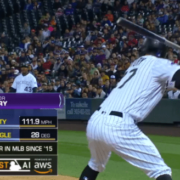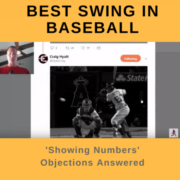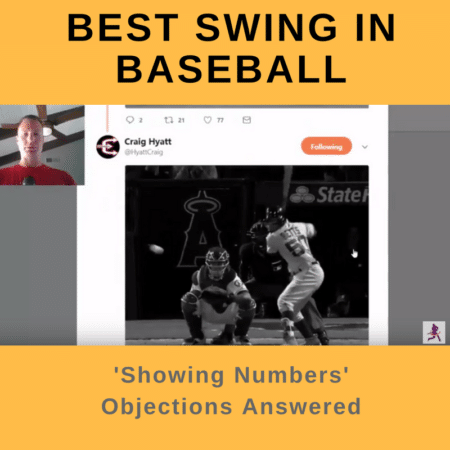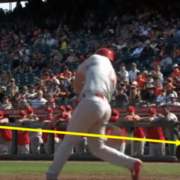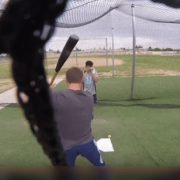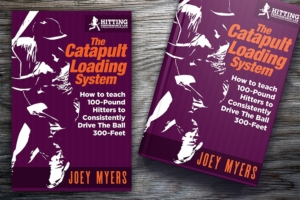I purchased this book last winter not only to teach myself but also my 5 year old son. I also purchased a Zepp’s Swing Tracker at the same time. While I read and began to understand the principles of this book, my son was in the basement establishing a baseline with the Zepp’s. His swing at 5 and 46 lbs was in the mid 20’s, good, bad, don’t know, don’t care. One month into utilizing the techniques in this book, his bat speed climbed to 42mph. True speed comes with consistency and continued practice will make it perfect, if there is such a thing. Now at 6 and and 47 lbs his bat speed is around 48 mph. Thank you for this book, I truly do believe it can give anyone a path to success, as long as they are open minded, read, and believe.
I read your book the other day. I have only been using some of your Facebook posts to help my daughter with her swing, without understanding the CLS. She used to squish the bug, but had a ton of bat speed and power. She now weight transfers but lost bat speed and power. Can’t figure out why. Well I read the book and we tried it today. Holy Sh!t!!! She was hitting around 68 EV with he squish bug, and jumped up to 75-78 regularly with weight transfer, but still felt like less power. I don’t have the tools to measure it anymore, but it has to be in the low 80’s. She used to be able to polish off 2 buckets of balls in a short time, 80-100 balls. Now after several swings, she needs to stop to recoup her energy, but says it feels like she’s not even swinging hard at all, and the ball is jumping. She did about 40 swings and was done. Made a believer out of me real quick. And she understands the technical terms and understands the concept real well.
My son is 12 and I have used some of the teaching the Hitting Performance Lab are posting on here and my son hit the ball over 280 feet several times already in the game not just practices and also hit the fence on the fly on 300 feet field, so what this guy is teaching works, a least for my son…He weighs about 110 now, but what I have noticed is how consistent his power has become thank you so much for your help, I played 10 years of professional baseball and I wish I could of used some of this advice.
Trevor Story 505 Foot Homerun: The Biggest Lies From Hitting Guru #57
Was it because of Coors field? High altitude is part of the equation, adding about 5% to batted ball distance according to bat-ball collision expert Physicist Dr. Alan Nathan. CLICK HERE, scroll down, and read under the subhead, “Effect of Altitude on Batted Baseballs”. So the Trevor Story 505 foot homerun at Fenway would have landed about 480-feet from home plate. Still, not bad.

Trevor Story 505 Foot Home run: check out him ‘showing those numbers’ & ‘hiding those hands’! Photo courtesy: MLB.com
Corked bat? CLICK HERE for a paper Dr. Nathan wrote studying the effects of corked bats on batted ball distance and concluded:
“Although the present study shows that corked bats do not result in longer home runs, it makes no statement about whether home runs might be hit more often with a corked bat.” – Top of page 577
Body mass? According to Baseball-Reference.com, Trevor Story is 6’1″, 210-lbs. The Trevor Story 505 foot homerun is the longest dinger in Statcast history, at Coors field, surpassing Giancarlo Stanton’s (6’6″, 245-lbs) record by 1-foot at the same ballpark. Bat speed is a better indicator of batted ball distance than body mass…Dr. Alan Nathan said this to me over the phone.
Any other excuses out there besides good effective hitting mechanics? 😛 ANY hitter with the optimum launch angle, and hitting the right part of the bat is one of the best starts.
Hitting Guru #57 will have a hard time explaining some of the things in the above Trevor Story 505 foot home run video analysis. We’ll be answering the question of how the Trevor Story 505 foot homerun happened:
- Trevor Story 505 foot homerun (and the other 2 other dingers he hit in the same game),
- Legs v. Spinal Engine – legs not necessary for locomotion, they’re an enhancement,
- Locomotion of a quadriplegic,
- Water Polo throw, and
- Anthony Rizzo homer falling down.
Here are some Hitting Performance Lab posts mentioned in the video:
- The Swing DOES NOT Start From The Ground & Move Up?
- Is Rotating Back Hip Through Zone Necessary For Power?
Best Swing in Baseball: Here is a Method Helping Mookie Betts – And Many Others – Consistently Crush The Ball
In this best swing in baseball video, we’ll discuss:
- Data and reasoning because personal opinions are seldom useful,

Mookie Betts (via my Twitter feed) ‘showing numbers’ at landing on inside pitch…Hitting Guru #57 “should NEVER ‘show numbers’ on inside pitch” objection based on personal opinion with ZERO data to back claim :-/
- Anatomy Trains
, The Spinal Engine
, Dynamic Body
, WeckMethod, Matt Nokes, Homer Bush
, Aaron Miles, and numerous past and present professional hitters agree with CLS,
- Objection #1: Increases Time to Impact because turning away from impact – twisting balloon analogy,
- Objection #2: Hitter loses vision and tracking of the pitch – “back eye test“
- Objection #3: Not on inside pitches – hitting “belly button” catcher’s glove,
- Can eat soup with spoon, fork, knife…but only one way is more effective. Teaching hitting is the same. Apply human movement principles that are validated by REAL science, NOT “because-I-said-so ‘bro-science'”, and
- The information is out there, so hitters will find it for themselves, either you will be able to take credit for teaching it or you won’t. Results don’t lie.
Still don’t believe the best ‘show numbers’? CLICK HERE for a post I did recently titled, “Why I Teach Hitters To ‘Show Numbers’ (And Maybe You Should Too)”.
Don’t be like opinion-based Hitting Guru #57…have solid data and reasoning to back up your “opinions”.
Leg Kicks May Be Dangerous To Pitchers (And Hitters That Don’t Perfect Them)…
Before I get into the Rhys Hoskins swing breakdown video featuring Mark DeRosa & Cliff Floyd above…
I wanted to give you a heads up of what’s in this post:
- Lesson learned from my school of hard knocks,
- How to fix striking out every at-bat in tournament, and
- Rhys Hoskins swing breakdown.
Lessons Learned from School of Hard Knocks

Rhys Hoskins says his thought is “down to the ball”, then adds, “obviously you’re not swinging down like you’re chopping wood.” He’s hoping that thought process will keep him on a level plane in the strike-zone as long as he can. Photo courtesy: Sports Bay Area
I recently worked with a newer 12/13u hitter of mine, where he shared he had a terrible tournament, where he struck out virtually every at-bat the weekend before.
This immediately raised a red flag for me.
The easy thing to do for a player – and a dad or mom – is to point to a breakdown in hitting mechanics.
As a hitting coach, if this isn’t your first rodeo, then you know this is not the case a majority of the time.
Quick back story,
My last year of Little League was insane:
- Hit .880 regular season, .770 in All-Stars,
- 30+ dingers,
- 40+ doubles, and
- Struck out a grand total of 3 times in the span of 6 months.
By the way, looking at old VHS video of that swing, I was doing what I teach now. All those strikeouts were early in the regular season, and once I settled down, they vanished entirely.
I was ignorance on fire!
Brace yourself for the “fall”…
The next year I made the move to the big field, with no pitching distance transition like there are nowadays. I found myself swinging and missing A LOT.
I got so frustrated with myself, and what do you think my dumb brain thought was the problem?
Right-O!! Mechanics.
Do you know the REAL cause?
Let me give you a clue…the word starts with a “T” and ends with “-iming” 😛 lol
I was being driven by my fear of getting “caught up” to by other players. And yes, the whispers started in Middle School when I struggled to recover my old swing.
Do you know how much of a nightmare that is for a hitter who’s super driven to succeed like I was?
This fear drove me into the bookstore to read every book on hitting I could get my hungry teenager hands on. Ted Williams, Tony Gwynn, Charlie Lau, Mike Schmidt, and on and on. Nothing seemed to help. I obsessively watched film of that swing trying to figure out what I was missing or leaving out.
Hey, at least I wasn’t out stealing cars!
It was a 4-year mind-fudge that ended in recovering my batting average – somewhat – but not my power the last two years in High School. Thinking back now, it’s a miracle I ended up with a scholarship at Fresno State.
The point of this story is, negative tournament outcomes don’t necessarily mean a breakdown in hitting mechanics.
Back to my young hitter…
How To Fix Striking Out Every At-Bat in Tournament
So I had three questions I planned asking my hitter, in diagnosing the challenges he had with his last tournament:
- The first one is, were you focusing on the new stuff we worked on last lesson (which was a week before), during game at-bats?
- If the answer is NO to that question, then I would ask, how many strikes did you swing at, OR not swing at?
- If they’re swinging at good pitches, then on the swings you took, how many were “on-time”?
If they pass the first three questions, then we look at seeking and fixing the ineffective swing mechanic.
However, this particular hitter failed question one. I hadn’t warned him about bringing new swing techniques into game at-bats. I told him that in games, your focus MUST be on swinging at good pitches and getting on-time. It’s to compete.
I teach hitters my painful lesson.
The good news is, this hitter will be on the up and up again, and won’t have to go through the frustration, struggle, and anger I went through attempting to fix something I knew nothing about at the time. And frankly, the only one who had a clue was Ted Williams, but his message was drowned out in the other white noise I was hearing, reading, and watching. Paralysis by over analysis.
Now, let’s tie in the Rhys Hoskins video above…
Rhys Hoskins Swing Breakdown
Below you’ll find video notes I took. Afterward, I’ll only focus on about a couple of these, I think others will make for good conversation in the Comments section below…
- About 1:20 min mark, DeRosa: “Hands go along for the ride…not a lot of hand load”
- About 1:40 min mark, DeRosa brings up examples of “violent hand loads” featuring: Cecil Fielder, Vlad Guerrero, Gary Sheffield…and Manny Ramirez, Buster Posey, Justin Turner, and Daniel Murphy used as examples of “not a lot of hand load”
- About 2:20 min mark, DeRosa: asks Rhys is he’s conscious about his pre-swing hand movement. Rhys says all he’s worrying about is having some separation between his body and where his hands are during load
- About 2:50 min mark, Rhys: “The only thing I’m thinking about is getting my leg up”. Cliff Floyd talks about having a leg kick is a perfection type of approach. Pitchers are trying to disrupt a leg kicker: tempo, changing speeds, etc.
- About 3:20 min mark, Floyd says Rhys has something you can’t teach: “He hits the fast-ball, he hits the curve-ball, he hits the change-up”…Floyd says it’s going to be tough to get him out when he covers the plate well and doesn’t like to strikeout.
- About 4:00 min mark, Cliff Floyd goes into more detail about a hitter focusing on perfecting the timing of a leg kick, and not worry about anything else, or else you’re screwed. Rhys talks about getting “inside the pitcher’s rhythm in the on-deck circle”. Cliff Floyd comments: “Did I pay attention to what that pitcher really does consistently” with his timing and rhythm in the on-deck circle.
- About 5:10 min mark, Mark DeRosa is wanting Rhys to explain the use of his hands and back elbow. Cliff Floyd says if you want the kid to go into a slump keep talking about hands and elbows. Rhys says his thought is “down to the ball”, then adds, “obviously you’re not swinging down like you’re chopping wood.” He’s hoping that thought process will keep him on a level plane in the strike-zone as long as he can.
- About 6:10 min mark, talks about “knee to knee” “hover” leg kick. More balance, don’t get over backside.
A lot more good than bad in this video. I wanted to focus on the timing aspect though…
Just to be upfront with you, I’m not one of those instructors that teaches a leg kick to ALL my hitters. I think this is a BIG mistake. If my hitter doesn’t have what I call a “Float” (aka stride type) built into their swing already, then I ask them to experiment a little. Or if what they’re using isn’t effective at getting them on time and dynamically balanced, then we get resourceful.
We experiment with:
- A leg kick (medium or high),
- Slide step, and
- Toe-tap.
By the end, they find that one of these techniques allows them to time the ball better, and it may not be what they started with. We’re looking for what they’re comfortable with, and can execute the swing dynamically balanced.
You heard Rhys Hoskins say,
“The only thing I’m thinking about is getting my leg up”
This was after DeRo prodded him to explain what his hands and back elbow are doing. Cliff Floyd got on DeRo that he’s going to force Rhys into a slump with all this hands talk! lol
Floyd also said that a lot of time and energy needs to be spent on perfecting the timing of the leg kick. He added, “Did I pay attention to what that pitcher really does consistently” with his timing and rhythm in the on-deck circle. This is very important.
Some of my good hitting friends online, who I highly respect in their knowledge, don’t believe timing can be taught or calibrated. I respectfully disagree.
If you can teach a pair of chickens to play ping-pong, then yes, timing can be taught. True story by the way – with the chicken (read Don’t Shoot The Dog: The New Art Of Teaching And Training).
I’ve also heard pitching coaches on the Socials say they lick their lips when seeing a hitter with a leg kick. And you heard Cliff Floyd address a pitcher’s job is to disrupt a leg kicker by changing their delivery tempo, changing speeds, etc.
But then Floyd turns around and compliments Hoskins saying, “He hits the fast-ball, he hits the curve-ball, he hits the change-up”…and adds, it’s going to be tough to get him out when he covers the plate well and doesn’t like to strikeout.
Calibrating a hitter’s timing and pitch recognition training are a deadly combination for pitchers who salivate over seeing a leg kicking hitter. I asked this coach whether he’d salivate over facing Josh Donaldson, Justin Turner, or Mike Trout. He didn’t answer.
Coaches, if you don’t give hitters tools for their toolbox, then they’re up there hitting blind. Don’t make them hit the pinata blind folded!
Here are some resources to take back to your hitters on timing and pitch recognition:
- 2-Plate and Float Variance Drills (you can also have hitter switch bat sizes and randomly throw different ball types to train timing as well),
- “Load slow and early” post,
- Random Pitch Drill (read Cal Poly study under sub-heading “Myth of Massed Practice”)
- Pitch Recognition interview post with Dr. Peter Fadde, and
- Effective Velocity interview post with Perry Husband.
You can teach timing. You can teach pitch recognition. Woe to the pitcher that pitches to hitters who train both. The winds of change are a blowin’ for hitters over pitchers. When troubleshooting with your hitters, remember:
- The lesson from my school of hard knocks,
- How to fix striking out every at-bat in a tournament, and
- Timing lessons from Rhys Hoskins.
Cody Bellinger Swing Dissection: How To Get “What’s Real” Out Of “What’s Feel”
Thome on Bellinger – MLB Tonight
“His hands are absolutely electric.” – Jim Thome on Los Angeles Dodgers sensation Cody Bellinger
Posted by MLB Network on Tuesday, June 27, 2017
I have a treat for you (and it involves the swing of hot hitting rookie sensation Cody Bellinger)…
…an analysis of an analysis if you will! lol
I’ve been licking my chops over the past week, to share the above video that multiple reader-friends asked my opinion on.
This was a perfect opportunity to discuss the “real” versus “feel” debate that confuses many new coaches.

Look how well Cody Bellinger uses Knee Action to consistently “get under” the ball. Photo courtesy: MLB.com
And here are interesting Jim Thome talking points from the above video (watch this first, don’t jump ahead to the video below):
- “Hit through the middle…not hook the ball”. Not letting top hand get out in front at impact…wanting to keep “bat flat” or flush at and through impact (about 1-min & 3:00 mark)
- Want wrists to come through impact towards the pitcher, Harold Reynolds using terminology “stay inside the baseball”, Thome saying “stay through the baseball”…Thome makes comment that this game will tell you what to work on next (about 2:00 min mark)
- About Cody Bellinger’s swing: “Hands are absolutely electric”, back leg is straight (during stance), knob points down to back foot, back foot has a little bit of turn in it…allows hips to get through? Everything stays straight (he mentions “level” later in the video) to the baseball with shoulders and pelvis, hands are above the baseball (about 3:30 mark)
- “King of the Mountain” Drill…down to the baseball means level to the baseball, barrel flat and level with the baseball, hit middle to a little bit below. Hit middle of the ball, not bottom or top. Hands above the baseball. (about 4:50 mark)
- Load slower and control my breathing…”diving steep”, not falling forward committing too much weight forward. Good drill for controlling forward momentum (about 6:50 mark)
- Straight back leg, turning the back toe slightly forward toward the pitcher. Creates torque in the back hip. (about 8:15 mark)
I was just going to do a post and ask for your thoughts on this Cody Bellinger swing analysis, but some of the talking points fired me up, so I couldn’t help myself with the following analysis of the Jim Thome analysis… 😉
Yes, I know, the video is a bit long, but there are MANY gold nuggets in there I think Jim Thome touched on, EVERY coach can learn and share with their hitters.
Here’s a list of my talking points (in this order)…
Addressing Jim Thome Comments of Cody Bellinger’s Swing
- “Hands electric”,
- Back Leg Straight,
- Knob points down at stride landing,
- Back foot turned slightly in towards pitcher (Supple Leopard
book by Dr. Kelly Starrett), and
- Shoulders/Pelvis should be straight or level.
And,
Jim Thome General Swing Comments
- Hit through middle – “flat” or flush with impact,
- Game tells you what to work on next (Golf Flow
book by Dr. Gio Valiante)
- Load slower, control breathing (CLICK HERE for this Jose Bautista video that discusses “load slow and early”,
- “Diving deep” cue,
- Swing down, and
- Barrel above the hands.
Please share any comments, questions, or criticisms below… 😀
Dramatically Improve HOW Your Hitters Learn By Listening In On A Local Lesson of Mine
- Part 1 – [You Are Here] Dramatically Cut Your Hitter’s Learning Curve In Half By Doing This…
- Part 2 – Dramatically Reduce Time To Impact Without Losing Power
- Part 3 – How To Develop Powerful Wrist Snap Like Hank Aaron (Is Devastating For Pitchers)
Here’s what I have for you…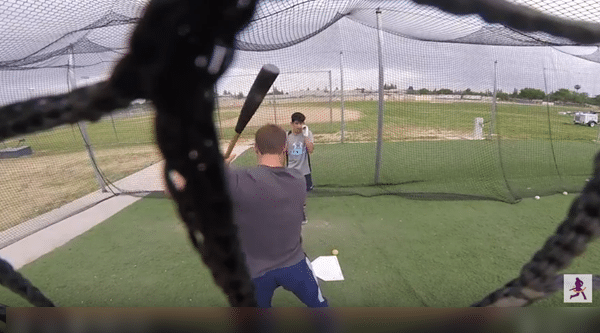
The above video is Part-1 of a three part series showcasing a local lesson of mine.
The objective of this video series is to share with coaches – literally – an “over-the-shoulder” look at how I do a local lesson. More on this in a moment…
Zack is a 14-year-old hitter from Visalia, California, which is approximately an hour drive from me, one way. And this is the first time I worked with him since about a year ago. We’ve had about half a dozen session together in total.
Before we started this session, Zack was having a challenge with hitting line drives. He was either hitting the ball on the ground or non-productive balls in the air.
DISCLAIMER about the video:
- Fortunately the video quality is great because Dad used his GoPro, but unfortunately I wasn’t mic’d up, so the audio isn’t like some of my other videos.
- We’re at a public High School on a Saturday afternoon, so there are other team noises, bird sounds, emergency vehicles, etc. going on in the background that can be distracting.
Now, what’s in this Part-1 video?
Let me expand on the video’s objective and how it can benefit coaches…
I get questions every week on how I’d run a practice or one-on-one session. This is an over-the-shoulder look. The main objective of this video series is to demonstrate how I use some of the “sticky” coaching principles covered in this post, and in my new book The Science Of Sticky Coaching: How To Turn Ordinary Athletes Into Extraordinary.
Sadly, a few coaches on the socials will be overly critical of this hitter, and I’m asking you to suspend judgement. The purpose of this video IS NOT about being overly critical of the hitter’s swing, it’s about the demonstration and use of sticky coaching principles.
With that being said, swing suggestions are welcome, but be nice coaches. Also, coaching suggestions are welcomed…but again, be nice.
Now, for those coaches looking to learn and help their hitters get better…ONWARD!
A typically lesson I do, is organized like the following, from start to finish (I’ve cut some parts out of this video for the sake of brevity):
- Dynamic warm-up,
- Beginning Ball Exit Speed readings,
- Record and analyze current swing,
- Lesson, and
- Ending Ball Exit Speeds readings.
What you can look out for in above video
- Talking about how to pick the right bat size (1-3:30 min mark),
- Showing him Miguel Cabrera’s landing position top hand and elbow positioning on my phone after video analysis of Zack’s swing (about 7-min mark),
- Working on Zack’s top hand Finger Pressure (about 8-min mark),
- Switching bats – over-loading with heavier end loaded bat with goofy PRX knob (about 13-min mark), and
- Teasing the Part-2 video where we talk about lowering Zack’s hands to not get above armpit line to landing – and the benefits of (about 15:30-min mark).
Also, when it comes to sticky coaching principles, notice how I:
- Move the tee positioning around after every swing (both high/low and inside/outside),
- Vary soft toss heights and depths,
- Vary mechanics on certain swings in a 5-swing round (I call these Varied Rounds), or practice one thing the whole round (I call these Block Rounds),
- Ask quite a few feel, visual, and/or audio feedback questions AFTER round is over (think of it like a hitting quiz),
- Keep my mouth shut during the 5-swing round (little to no feedback from me),
- Don’t make Zack take a lot of swings during our time together,
- Have him change his bat size during rounds, and
- Work with him on simplifying the juggling of a couple different mechanical cues.
How a Dad Turned Around His Struggling 16-year-old Fast-Pitch Softball Daughter’s Swing in 1-Day?

1-day difference between swings, yes I know one is a game swing and one is off the tee, one is a back view and the other is a chest view, but the changes are still dramatic…
I was blown away by an email I recently received from the dad of Kelli, a struggling 16-year-old fast-pitch softball hitter…
And by the way, the following email was unsolicited, much like Marty White’s testimonial in this post about his son, 14-yo Hudson White, who participated in Brian Domenico’s 2016 National Power Showcase hitting 11 consecutive dingers out of the Texas Rangers ballpark in Arlington, averaging 398-feet, at only 5-foot 7-inches, 130-pounds.
I feel the following story of Kelli’s struggle holds true for quite a few baseball and softball hitters out there, and I wanted to share it. It breaks my heart to hear the BEFORE stories. But without the bitter baby, the sweet ain’t so sweet!
Please pay special attention to how Mike introduces new hitting content to his daughter. Sometimes this can be a slippery slope with parents and their daughters and/or sons.
DISCLAIMER: results aren’t typical. Hitters getting “it” or “not” depends on a few things: 1) Player engages in consistent deep practice, 2) Coach successfully connects player to message (the WHY), 3) Material presented in a way to set player up for success not overwhelm, and 4) Coach taps into player’s primary learning style to name a few of the biggies.
Enter Mike’s email…
“Joey: I saw your book “Catapult Loading System” on Kindle and figured I’d take a chance on it because I have always liked to read different philosophies on hitting. I’ve been coaching my daughter and her teams in fast-pitch softball for over 8 years starting with Rec through Club ball here in AZ.
Lately, to my disappointment my daughter has taken a break from club ball for the last 6 months but has just started playing again on her High School JV team. She is a power hitter but has been struggling with weak grounders and pop ups.
After I read your book I asked her to work with me for 10 minutes a night hitting into the net off a T.
(She’s 16 and this was all could get out of her, so I took what I could get.)
I noticed when I took some videos of her during games that she was stepping into the bucket on her stride and was leading her hands with the back elbow, which I know is a no, no and creates bat drag.
Those two things combined were causing her to dip the bat off plane and not hit the ball solid, causing the pop ups and grounders. She was basically trying to “lead with the hips and start her swing from the ground up” like I had been teaching her for years.
After reading your book, I didn’t want to overwhelm her or totally change her swing so I just focused on the bottom three fingers of the top hand tightening in the swing and showing the numbers by loading the shoulders as you explain in the book.
I also told her to shorten her stance a bit so she would focus on loading the shoulders (showing the numbers and hide the hands) rather than taking a big stride and stepping into the bucket.
I wish I could send you the videos of the before and after of her swing after one 10 minute session. I’m not kidding when I say that it was almost an “instant” change for the better.
What I noticed by having her tighten her bottom three fingers on the top hand, is it forced her to keep her back elbow in the slot and her hands to stay in front of the back elbow. This immediately corrected her bat head to stay on plane in the zone longer with no casting or weak bat angle.
I also noticed that by having her load with the shoulders rather than relying on her hips with a big stride, she didn’t step into the bucket or fly open with her hips.
These simple little tweaks helped to correct the things I’ve been working with her for years but to no effect. I couldn’t believe the difference from such a small simple adjustment.
I’ve told some of my softball friends and fellow coaches about it and they just look at me and chuckle like I’m making up some kind of tall tale. I’ve even shown them the before and after video and they still seem skeptical.
But here’s the bottom line…
The day after I worked with my daughter for all of 10 to 15 minutes, literally hitting about 35 or 40 balls off the T, against one of the best teams in our division, she got up with two runners on, with two strikes and launched a bomb for a three run HR. She went 2 for 2 that day.
That night we spent another 10 minutes working the same drills and the next day, she did the same thing on her first at bat hitting another bomb. She went 3 for 3 that game.
Now look, I’m not a scientist nor am I into hockus pockus but I have to admit I’m a true believer and just had to tell you about our instant success by using some of the small tweaks you talk about. I plan to keep using these ideas and I’m going to re-read your book again to make sure I didn’t miss anything.
Thanks for the info and know you have another success story here in Arizona.” – Mike Monaghan
After I asked for Mike and Kelli’s permission to publish her story and for the BEFORE and AFTER videos to do analysis on, I received this follow up from dad…
“I apologize that these two videos are from a back vs front view but the differences can still be seen. The before video is a game swing with her uniform on and are only a day apart. If you can run them in slow motion, you’ll notice a couple things that made the world of difference.In the before:
- Wider stance (in my opinion, too wide)
- More lateral movement because she doesn’t load at the shoulders (show her numbers)
- Steps in the bucket as her hips fly open
- Back elbow is leading the hands
- Bat angle is well below the ball plane as she starts her swing
- Result….pop up to pitcher
After video:
- All we worked on was tight bottom three fingers on top hand, loading at the shoulders (showing the numbers) and a slightly narrower stance. Results:
- Back elbow is behind the hands and she has a much more solid impact on the ball
- Bat head stays on plane with ball longer allowing a line drive impact on ball (not too much bottom half or top half on the ball)
- She doesn’t fly open with her hips and her body stays in alignment longer (notice where her foot lands on the second video…..right on the line in the cement on the floor.) I think the shoulder load (and I know she could probably show even more of the numbers if we keep working on it) prevents her or at least minimizes her from flying open. You probably have a video link to some sport’s scientist that can explain how the shoulders and spine work together and keep the hips in check….Lol!
Bottom line results….2 HR’s in two games….much more solid impact on other hits.Stepping in the bucket has been a huge issue we have tried to correct for years with little to no success and although I know we need to keep working a couple minutes a night to turn these tweaks into habit, I still can’t believe how quickly she made a change. It might also explain why I get so many skeptical looks and opinions when I talk about your book to other coaches and show them the results after a one day difference. If I hadn’t witnessed this with my own eyes, I’d probably be skeptical too.Her instant success has also done a few things I never thought possible. She actually likes working with me in the garage hitting into the net at night because it is no more than a 10 minute session and she can still enjoy being a teenager. She actually will listen to my instruction and corrections and wants me to video her so she can see that she’s doing it correctly. When she was little, we use to go to the park and hit 100 balls off a machine or soft toss but those days of daddy/daughter time are limited so a 10 minute session is something she is OK with. Its a win/win for both of us.”
Thank YOU Mike I appreciate your support. Great approach in getting that young lady of yours “hooked” again. It sounded like a tall order, but you pulled it off nicely Coach. I’m proud of both of you!
Also Mike, here are my next step swing suggestions:
- CLICK HERE for a video on how to fix stepping in the bucket using resistance bands,
- Finish up with the rest of the concepts in the Catapult Loading System book, then…
- CLICK HERE for the Float Variance Drill, and
- CLICK HERE for a definitive guide to forward momentum.
For those of you who may have missed Coach Mike’s effective approach with his teenage daughter, here are a couple key points:
- Mike set his daughter up for success by telling her to only commit 10-mins per day to this new information (I tell my hitters to spend 5-mins/day, at least 4-days/week in deep practice),
- He had the humility to admit (to his daughter I assume) that his teachings may have been misplaced in the past (this is part of a Growth Mindset by the way),
- Didn’t want to overwhelm her, so Mike started with one thing first, “Finger Pressure”, then when she got that, he moved onto “Showing Numbers”, and lastly
- Mike has a “results don’t lie” story to tell the naysayers, whether they heed his advice only time will tell…but the truth is undeniable.
This works for softball players folks…not just baseball. If you aren’t growing as a coach, then you’re dying. Dead things get thrown in the trash. Cultivate a Growth Mindset coaches or else you’ll be short changing your players, and your significance as an effective coach.
The times are a changin’…
UPDATE on Kelli…
Joey: You had asked me to keep you up to date on how Kelli had progressed after I worked the Catapult Loading System with her. I’m proud to give you her final stats after 17 games. You can note that we worked the system after game 7, so her results were really proven in the last 10 games. Up until we worked the system, she had only one HR and most of her hits were weak ground balls in the gaps and bloopers over the infield. Although she had decent numbers before working the system as I had told you in previous emails, her hitting really came alive and her hits were much more powerful. She had very few if any extra base hits in the first 7 games and the triples and doubles really took off in the last 10 games. Although she was playing JV, we are in the 6A division playing some of the largest and most competitive schools in the state of AZ and she lead the team in almost every category or was in the top three out of 19 girls on the team.
- Games played: 17
- Batting Average: .652
- Plate Appearances: 48
- At Bats: 46
- Runs scored: 22
- Hits: 30
- RBI: 26
- Doubles: 9
- Triples: 2
- HR: 4
- BB: 2
- K: 1
- OBP: .667
- SLG: 1.195
- OPS: 1.863
You Too Can Get Your Hitters To Sharpen Plate Discipline, Re-Calibrate Timing, & Barrel The Ball More Often In Two 5-Swing Rounds Per Week With Distraction Training
(SAFETY DISCLAIMER: those that have had or are prone to epileptic seizures, SHOULD NOT use these goggles)…
Ongoing studies are revealing distraction training using Strobe Goggles are giving dramatic results from little use.
Here are a couple studies that were conducted…
PLEASE NOTE: The players and coaches were reminded of individual swing issues before and after each experiment period. During they were not. They were reminded of breathing, composure, and head position during the distraction. Generally and very often as encouragement and reinforcement.
A recent 6-week test was 5 swings without the goggles, 5 with, and 5 without, so 15 swings total per week. These hitters increased Ball Exit Speeds between 2 to 5-mph after the 6-week period.
Another recent 8-week study had hitters using goggles for 1-hour throughout the week, totally 100-150 swings per week. Swings without the goggles were mixed in throughout the week as well. These hitters averaged 14.3-mph Ball Exit Speed increases at the end of the 8-week period.
We can safely say that between those numbers we’ve seen a relative increase in positive performance output using the goggles.
My good friend Ken Carswell (KC) at HittersCode.com is SUPER busy cooking up brand new training gear disrupting how coaches practice:
- Plate discipline,
- Timing, and
- Barreling the ball more often…
…with their hitters.
If you remember, I did an interview with KC earlier in 2016, CLICK HERE to read that.
The Hitter’s CODE stands for:
- Cognitive
- Occlusion
- Distraction
- Environments
If you remember, video occlusion training is what Dr. Peter Fadde talked about in this interview I did with him – CLICK HERE.
Also, CLICK HERE to see how Perry Husband uses a pinch of distraction training to calibrate tracking and timing in this HPL interview.
Basically, KC the “Mad Scientist”, is putting together a “smart” hitter’s helmet that will benefit the three categories I mentioned before.
Here’s a taste of what’s coming (and is already here) with the distraction training helmet:
- Strobe Goggles as shown in the video above (Phase-1 and is a prelude to the helmet),
- Audio Distraction – this includes rhythm, disruption rhythm, crowd noise – boos v. cheers (Phase-1 and is coming when helmet is ready to launch at 2017 ABCA January conference in Anaheim, California),
- Phase-2 and details are in the works…
Believe me, distraction training WILL BE the FUTURE of hitting.
KC will reserve a spot for those interested in the distraction training helmet, so CLICK HERE to RESERVE YOUR SPOT today!

